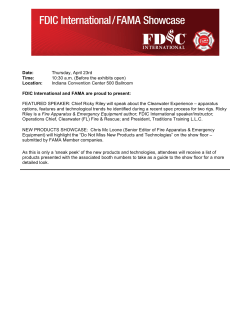
CEVO 3 Train-the-Trainer - Indiana EMS Association
Coaching The Emergency Vehicle 3: Fire In 2007, there were more than 60 deaths and 2,151 injuries from crashes involving emergency vehicles. CEVO 3: Fire is uniquely tailored to fire-apparatus personnel. This highly interactive, six-hour course explains how to use National Safety Council defensive driving techniques to maneuver safely through traffic under severe time constraints and stress. Since 1994, more than 500,000 fire-apparatus operators have been trained using CEVO programs — the standard in driver training for emergency vehicles. What you’ll learn: • • • • • • Creating the proper cushion of safety Properly positioning the fire apparatus Navigating through intersections Passing and changing lanes Determining adequate reaction time Handling blind spots and backing up CEVO 3 Train-the-Trainer Hosted by: Seals Ambulance Service 2400 Roosevelt Avenue Indianapolis, IN 46218 (317) 454-7774 Date and Time: April 25, 2015 0900 to 1530 hours Registration: Other safety-related topics • • • • • • Operating on various road surfaces and in adverse weather conditions Apparatus inspection Apparatus handling and design characteristics Driving with and without sirens Driving with and without sirens Safety at the fire ground, and more Vince Bellino Coaching Systems LLC (914) 474-7848 VB@CoachingSystems.com CoachingLLC@aol.com Coaching The Emergency Vehicle 3: Ambulance According to EMSresponder.com, ambulance drivers are twice as likely as law enforcement officers and three times more likely than firefighters to be killed while driving on the job. This highly interactive sixhour program adapts National Safety Council defensive driving strategies to the specialized nature of ambulance work, training drivers to navigate safely through traffic in both emergency and nonemergency situations. EMS personnel who complete the course and maneuvering skills program can earn 8 Continuing Education Units. What you’ll learn: • • • • • • Handling blind spots and leaving an adequate cushion of safety Navigating through intersections Learning proper ways to pass and change lanes Backing up properly and parking Steering clear of hydroplaning Avoiding tailgating and improving reaction time Other safety-related topics: • • • • • Recognizing nighttime driving dangers Approaching the hospital and dropping off patients Vehicle design characteristics and inspection Driving with and without sirens Safety at the emergency scene, and more
© Copyright 2025





















